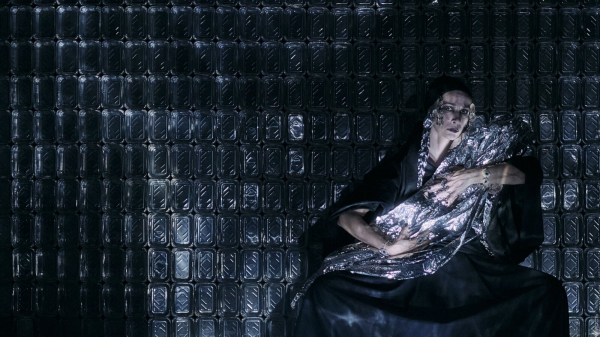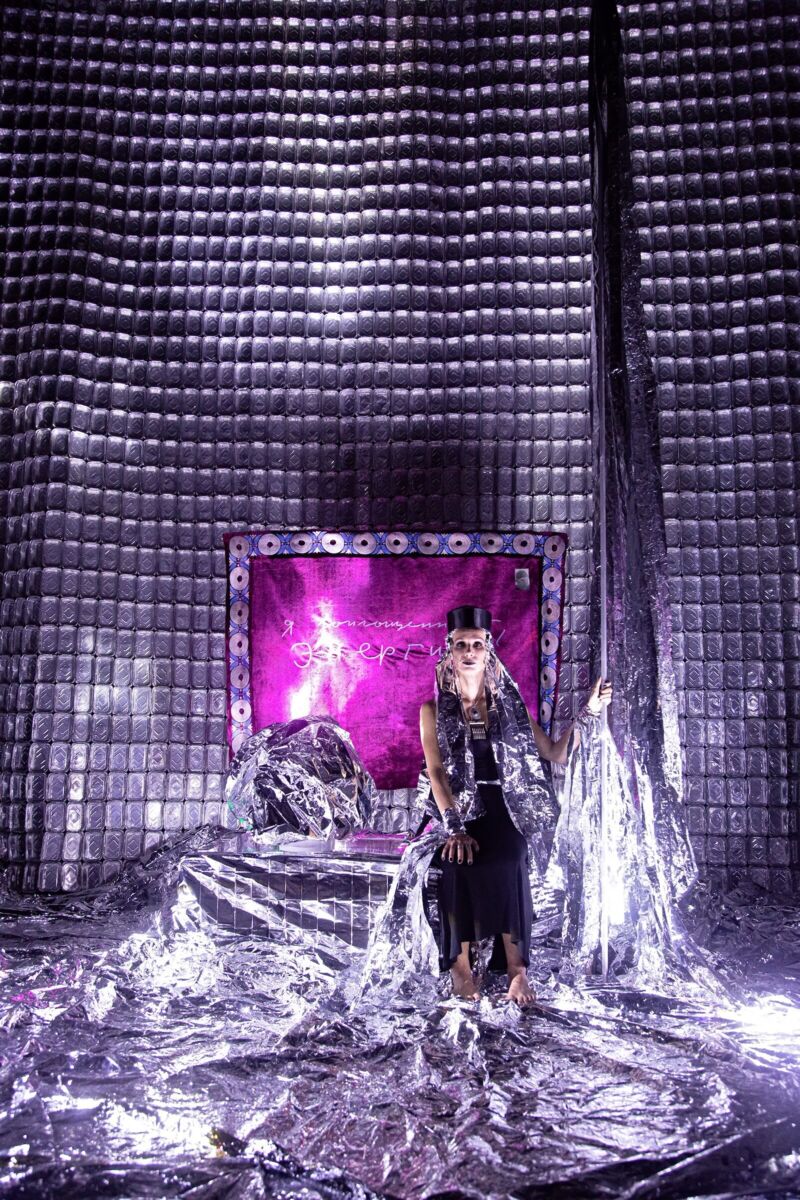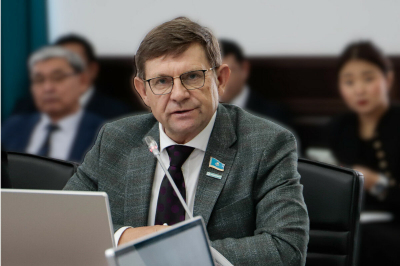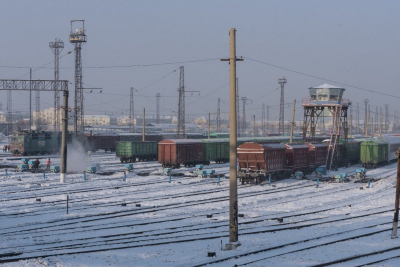The Magician and the Sorceress Against the Atomic Bomb
07.11.2025 09:38

ORTA’s production of “The Great Atomic Bombreflector”
Читайте этот материал на русском.
ORTA, an artistic group from Kazakhstan, presented its performance “The New Genius Experience of the Great Atomic Bombreflector” at the Seoul Mediacity Biennale, which runs this year from August 26 to November 23. The performance also took place last month in Germany at the Voices Berlin theater festival. Theater critic Elena Kovalskaya wrote a review of the performance and its effect on different audiences.
Before The New Genius Experience begins, spectators are given felt Kazakh skullcaps and a silver ribbon, which they are asked to wrap around themselves. They enter a vast box made of foil. We study the textures that reveal, in a merciless light, their banal nature—baking molds stapled together by the thousands, emergency thermal blankets glued into a theater curtain—while director Rustem Begenov, standing by a flip chart, explains how the performance is built.
This work is dedicated to Kazakhstan, which, after the invention of the atomic bomb and until the fall of the Soviet empire, served as a testing ground for nuclear weapons. Every three weeks, an atomic bomb was detonated here. For forty years. Six hundred and thirty bombs. A quarter of all nuclear explosions on Earth. Kazakhstan carries this unspoken trauma, still experiencing its consequences today.
Begenov and actress Alexandra Morozova, who together make up the company ORTA, are irradiated by something else as well: The ideas of avant-garde artist Sergey Kalmykov, who lived in their native Almaty. In the 1930s, Kalmykov came to this “edge of the Soviet Union” to escape Stalin’s purges. He worked as a stage designer at the opera theater and, in his later years, became known as the town madman, astonishing passersby with his eccentric appearance. In Kalmykov’s legacy—only discovered after his death—ORTA found a description of a device called the “Atomic Bombreflector” and the theory of New Genius, which holds that genius is not granted from above but practiced, and thus available to anyone.
ORTA built both these ideas into a ceremony of transforming evil into good. They first presented it in Moscow at a theater festival in 2021 [the Noname Festival at the Meyerhold Center — note]. Since then, the performance has appeared around the world at both theater venues and art biennales, as it combines elements of performance art and contemporary theater, fascinating curators with its freedom from prevailing rational frameworks, trends, and agendas. It is especially interesting to observe how the piece resonates in different contexts.
Within the framework of the 13th Seoul Mediacity Biennale, whose program Séance: Technology of the Spirit is dedicated to alternative forms of knowledge, the genre of The Bombreflector could also be described as a séance of magic. When Begenov leaves the stage and the lights go out, we witness a metamorphosis. Through the use of light, the space transforms: through a fluid, shimmering substance, we see a cosmos pixelated with stars. At its center stands the sorceress, fanning herself with streams of fire as she hums an ancient song. Her singing summons a creature, which circles around and obediently folds into a crystal in her hands. The sorceress softly sings to the crystal, invoking it.
This transfiguration repeats several times, hypnotizing the audience and inspiring trust in the transformation they, too, are about to undergo. A voice rhythmically reads out the coordinates of nuclear explosions in Kazakhstan. We vibrate under a rumble that mimics bomb blasts. The launch of the Bombreflector is announced—an immaterial device apparently composed of our fears, grief, and desires, transforming the energy of decay into the energy of creation. This new energy is directed toward the emanation within us of genions—the primordial elements of genius.
We test whether the practice has worked by extracting light from a battery and a bulb; on command we illuminate ourselves rapidly as the count rises: 56%, 82%, 100% — emanation successful. Piano music plays, and the entire hall begins to praise one another’s genius in chorus to the melody of the popular Kazakh song Dudarai. “Glory to you, Rustem Begenov! Glory to you, Alexandra Morozova!”


Under its bold concept connecting new technologies with unscientific knowledge, the Seoul Mediacity Biennale gathered a collection of works ranging from traditional practices to modern technologies in the service of occultism.
But what kind of alternative knowledge does ORTA rely on? On the intuitions of an artist whom no one understood during his lifetime—an utterly lonely man without family, friends, or followers. Yet, Kalmykov shared the faith of a whole army of Russian avant-gardists—the belief in art as a transformative force, in art’s ability not to imitate reality but to be reality, to change it. In the end, the avant-gardists believed that art could create the future through creative acts, igniting its participants and urging them toward new dimensions of reality. That is how art changes reality.
The ideas of the avant-garde gave birth not only to such a medium as performance but also to participatory art that involves the audience in the event—and, more broadly, to art as a tool of social transformation.
In the late 20th century, this belief was often questioned. Claire Bishop criticized artists who, knowingly or not, simulated social change while being financed by states dismantling their welfare systems (Artificial Hells). Jacques Rancière, from an aesthetic standpoint, sharply attacked participatory art: “We have seen so many theatrical performances claiming not to be mere spectacles but unifying ceremonies. And even today, despite ‘postmodernism’ and its skepticism toward any intention to change the world, we see so many installations and performances imagining themselves as religious mysteries that it no longer sounds provocative to say that words are just words” (The Emancipated Spectator).
Begenov and Morozova do not share this skepticism. They practice the modernist ideas of Kalmykov as experimenters, testing how they work with today’s audiences. True to the modernist tradition, they manifest before they act. They involve the audience in the event, leaving no space for detached contemplation or private emotion. They embark on a heuristic experiment, entrusting the outcome of transformation to the participants’ faith and imagination. And they discover in the audience—if not faith in transformation—then at least a yearning for community, meaning, and mystery.
As for themselves, they do not merely believe—they are absolutely convinced that everything is possible. These words are inscribed on their banners. One of them can be seen in the second part of their project for the Seoul Mediacity Biennale: the installation The New Genius Temple of the Great Atomic Bombreflector, located in the Seoul Museum of Art (SeMA)’s main exhibition. It recreates the scenography of their performance in miniature: a foil well, where, alone with a “magic crystal,” focusing on crimson embroidery to suggestive music, each visitor can awaken their own “genions.”


These embroideries, hand-stitched by Morozova in the traditional biz keste technique, are varied and numerous—they have become a kind of standard under which ORTA leads its global campaign. On the one displayed at SeMA are Kalmykov’s words:
“In the world, and equally in darkness, there is nothing unrealizable. Everything is possible. Everything is realizable in our world. All it takes is to want something.”
This kind of alternative knowledge—and the humor, uncharacteristic for other works at the biennale—came to the forefront in Seoul. Earlier, in Moscow at the Noname theater festival, something else stood out: among other productions from Central Asia, the creators of The Bombreflector appeared free from the inner struggle many artists face—wanting their art to be part of global art while resisting the self-exoticization that this inclusion often requires.
“If you’re expecting exoticism,” ORTA declared, “please, we’ll hand out dombras to everyone and sing a Kazakh song together in chorus.”
At the Venice Biennale in 2022, The Bombreflector amused audiences with the mismatch between its grand task and humble means: in Kazakhstan’s first-ever pavilion—an exquisite palazzo on the Riva degli Incurabili—ORTA represented its country through theater made, as they say, “from the most ordinary household materials.”
At the Voices Festival in Germany—a country where socially engaged theater is a publicly supported and accepted practice—audiences may be puzzled by such an archaic category as “genius,” and by the insistence with which spectators are drawn into the event. Above all, they may be surprised that the audience here is stimulated not toward outward action in social reality, but toward inaction and inner work. “Take the position of doing nothing, and things will transform themselves,” says the Sorceress at the end, quoting Zhuangzi.
Thus, involving and at the same time eluding the nets of agendas, programs, rules, and expectations, The Bombreflector continues its nomadic journey across the world.
Elena Kovalskaya is a theatre critic, curator, and teacher.
Sign up for our English-language newsletter.
Власть — это независимое медиа в Казахстане.
Поддержите журналистику, которой доверяют.
Мы верим, что справедливое общество невозможно построить без независимой журналистики и достоверной информации. Наша редакция работает над тем чтобы правда была доступна для наших читателей на фоне большой волны фейков, манипуляций и пропаганды. Поддержите Власть.
Поддержать Власть














